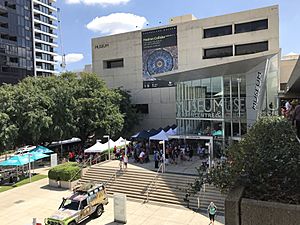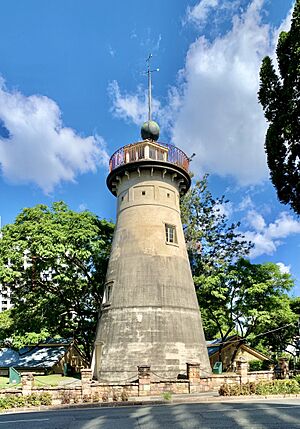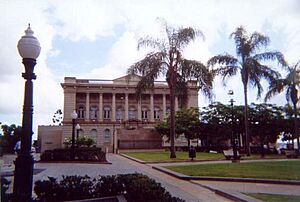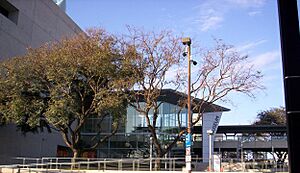Queensland Museum facts for kids

Queensland Museum at South Brisbane
|
|
| Former name | Queensland Museum |
|---|---|
| Established | 20 January 1862 |
| Location | South Brisbane |
| Collection size | 1,000,000+ |
| Visitors | 2,000,000+ |
The Queensland Museum Kurilpa is a super cool place in Queensland, Australia! It's like a giant treasure chest filled with amazing things about nature, history, science, and what people have achieved. This museum is the main one for the state of Queensland.
The museum gets its money from the Queensland Government. Its main home is in South Brisbane. But guess what? It also has special museums in other towns! You can find them in North Ipswich, East Toowoomba, and Townsville City.
Contents
A Journey Through Time: The Museum's Homes
The Queensland Museum started a long time ago, on January 20, 1862. It was created by a group called the Queensland Philosophical Society. One of the main people who helped start it was Charles Coxen.
Moving Around Brisbane
In its early days, the museum moved around a lot in Brisbane. Its very first home was The Old Windmill. It stayed there from 1862 to 1869. After that, it moved to Parliament House for a few years. Then, it was in the General Post Office until 1879.
A More Permanent Home
The Queensland Government then built a special building for the museum on William Street. The museum moved into this new home in 1879. It stayed there for 20 years, showing off its collections.
In 1899, the museum moved again! This time, it went to the Exhibition Hall. This building is now called the Old Museum. It's in a Brisbane suburb called Bowen Hills. The museum stayed in this beautiful building for a very long time, 86 years!
The Modern Museum
Finally, in 1986, the Queensland Museum found its current home. It moved to the Queensland Cultural Centre at South Bank. This is a fantastic spot right next to the Queensland Art Gallery.
There's even a special tunnel and a bridge that connect the museum and art gallery to the Queensland Performing Arts Centre. In 2004, lifts were added to the bridge. These lifts help people get to the Cultural Centre busway station.
What You Can See at Queensland Museum
The Queensland Museum in South Brisbane is a place where you can explore many different things. It's all about natural history, cultural heritage, science, and amazing human achievements. The museum has over one million items! These items tell the story of Queensland's nature and culture.
World Science Festival Brisbane
The Queensland Museum Network hosts a really cool event called the World Science Festival. They are the only ones in the Asia Pacific region allowed to host it! The first festival in Brisbane happened in 2016.
This festival takes place every March in Brisbane. It also has smaller events in other towns like Toowoomba, Townsville, and Chinchilla, Queensland. It's a great way to learn about science in a fun way!
Special Exhibitions You Might Have Missed
The museum often has special exhibitions that bring amazing things from all over the world.
- Afghanistan: Hidden Treasures from the National Museum, Kabul was a big exhibition. It ran from September 2013 to January 2014. It showed 230 priceless objects from ancient times, some as old as 2200 BC! These treasures gave a peek into the ancient Silk Road. You could see beautiful jewelry, sculptures, and gold items.
- Mummy: Secrets of the Tomb was another exciting exhibition. It featured four real Egyptian mummies! Plus, there were over 100 other items from the British Museum in London. This exhibition was open from April to October 2012.
Queensland Museum Medal
The Queensland Museum gives out a special award called the Queensland Museum Medal. It's given to people who do important research. The first medal was awarded in 1987. Some famous people who have received this medal include David Attenborough and Steve Irwin.
Returning Important Items
The museum has a program to return ancestral remains and cultural items to Indigenous Australians. These items were collected by the museum between 1870 and 1970. The program started in the 1970s. It's about showing respect and giving back what belongs to the Aboriginal and Torres Strait Islander people.
See also
- List of museums in Queensland
- North Stradbroke Island Historical Museum
- Returning human remains - Australia
- Steve Van Dyck, a senior curator who studies vertebrate animals
- Scott Hocknull, a senior curator who studies geology (rocks and earth)





